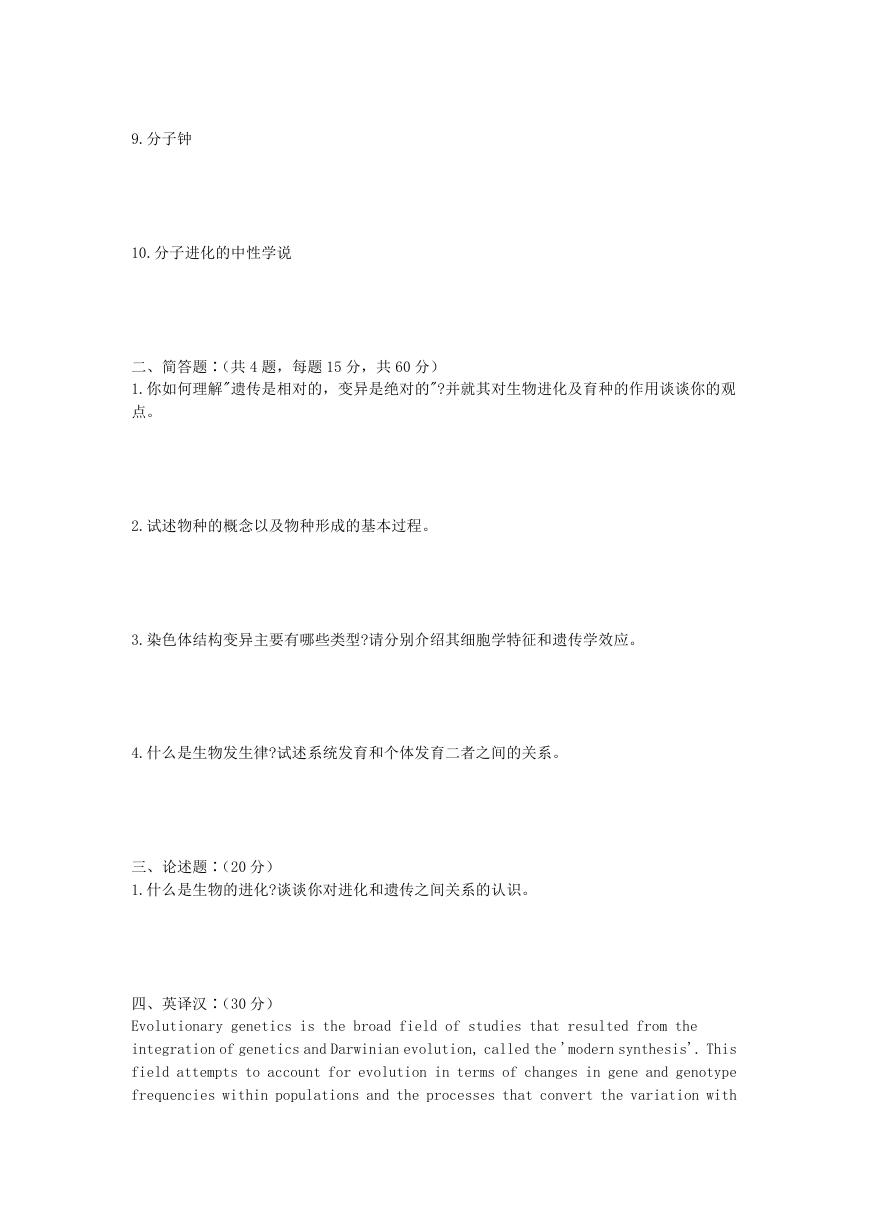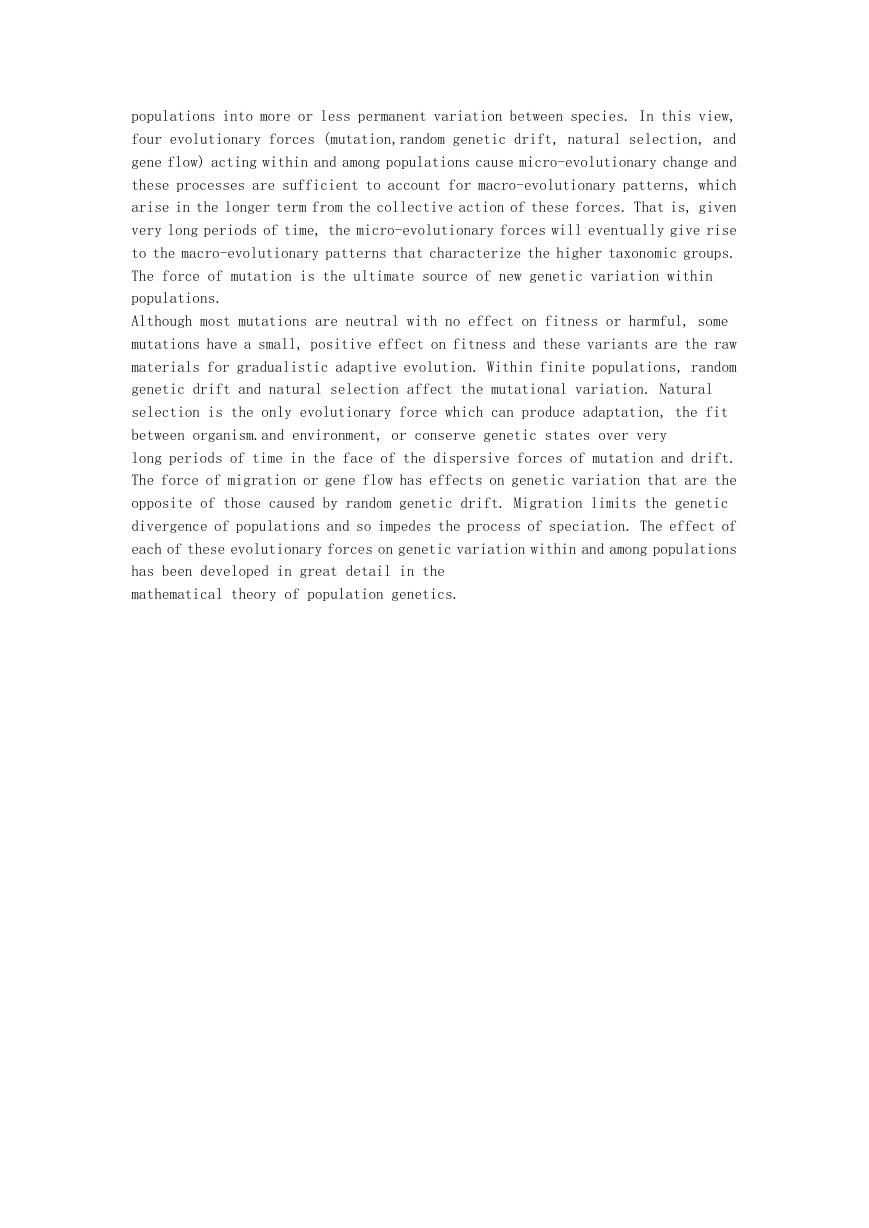2018 年安徽师范大学普通遗传学考研真题
一、名词解释(共 10 题,每题 4 分,共 40 分)
1. 基因组
2.共显性
3.中心法则
4.伴性遗传
5. 非同义突变
6.顺反子
7.数量性状
8. 基因型频率
�
9.分子钟
10.分子进化的中性学说
二、简答题∶(共 4 题,每题 15 分,共 60 分)
1.你如何理解"遗传是相对的,变异是绝对的"?并就其对生物进化及育种的作用谈谈你的观
点。
2.试述物种的概念以及物种形成的基本过程。
3.染色体结构变异主要有哪些类型?请分别介绍其细胞学特征和遗传学效应。
4.什么是生物发生律?试述系统发育和个体发育二者之间的关系。
三、论述题∶(20 分)
1.什么是生物的进化?谈谈你对进化和遗传之间关系的认识。
四、英译汉∶(30 分)
Evolutionary genetics is the broad field of studies that resulted from the
integration of genetics and Darwinian evolution, called the 'modern synthesis'. This
field attempts to account for evolution in terms of changes in gene and genotype
frequencies within populations and the processes that convert the variation with
�
populations into more or less permanent variation between species. In this view,
four evolutionary forces (mutation,random genetic drift, natural selection, and
gene flow) acting within and among populations cause micro-evolutionary change and
these processes are sufficient to account for macro-evolutionary patterns, which
arise in the longer term from the collective action of these forces. That is, given
very long periods of time, the micro-evolutionary forces will eventually give rise
to the macro-evolutionary patterns that characterize the higher taxonomic groups.
The force of mutation is the ultimate source of new genetic variation within
populations.
Although most mutations are neutral with no effect on fitness or harmful, some
mutations have a small, positive effect on fitness and these variants are the raw
materials for gradualistic adaptive evolution. Within finite populations, random
genetic drift and natural selection affect the mutational variation. Natural
selection is the only evolutionary force which can produce adaptation, the fit
between organism.and environment, or conserve genetic states over very
long periods of time in the face of the dispersive forces of mutation and drift.
The force of migration or gene flow has effects on genetic variation that are the
opposite of those caused by random genetic drift. Migration limits the genetic
divergence of populations and so impedes the process of speciation. The effect of
each of these evolutionary forces on genetic variation within and among populations
has been developed in great detail in the
mathematical theory of population genetics.
�






 2023年江西萍乡中考道德与法治真题及答案.doc
2023年江西萍乡中考道德与法治真题及答案.doc 2012年重庆南川中考生物真题及答案.doc
2012年重庆南川中考生物真题及答案.doc 2013年江西师范大学地理学综合及文艺理论基础考研真题.doc
2013年江西师范大学地理学综合及文艺理论基础考研真题.doc 2020年四川甘孜小升初语文真题及答案I卷.doc
2020年四川甘孜小升初语文真题及答案I卷.doc 2020年注册岩土工程师专业基础考试真题及答案.doc
2020年注册岩土工程师专业基础考试真题及答案.doc 2023-2024学年福建省厦门市九年级上学期数学月考试题及答案.doc
2023-2024学年福建省厦门市九年级上学期数学月考试题及答案.doc 2021-2022学年辽宁省沈阳市大东区九年级上学期语文期末试题及答案.doc
2021-2022学年辽宁省沈阳市大东区九年级上学期语文期末试题及答案.doc 2022-2023学年北京东城区初三第一学期物理期末试卷及答案.doc
2022-2023学年北京东城区初三第一学期物理期末试卷及答案.doc 2018上半年江西教师资格初中地理学科知识与教学能力真题及答案.doc
2018上半年江西教师资格初中地理学科知识与教学能力真题及答案.doc 2012年河北国家公务员申论考试真题及答案-省级.doc
2012年河北国家公务员申论考试真题及答案-省级.doc 2020-2021学年江苏省扬州市江都区邵樊片九年级上学期数学第一次质量检测试题及答案.doc
2020-2021学年江苏省扬州市江都区邵樊片九年级上学期数学第一次质量检测试题及答案.doc 2022下半年黑龙江教师资格证中学综合素质真题及答案.doc
2022下半年黑龙江教师资格证中学综合素质真题及答案.doc